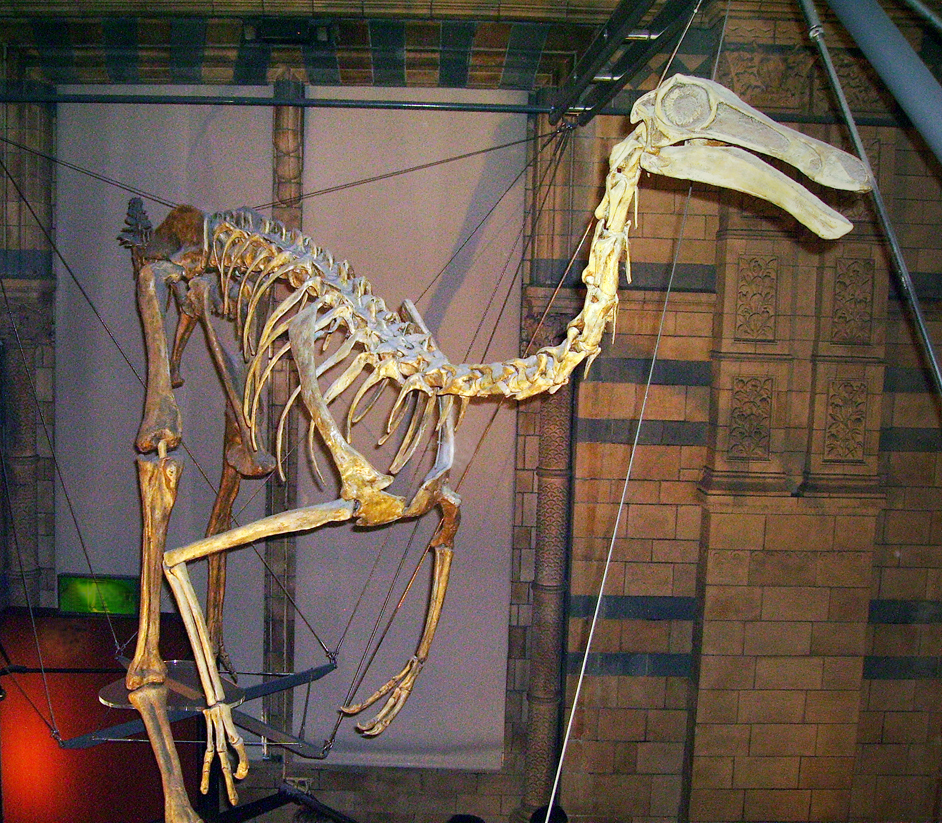- Gallimimus
Taxobox
name = "Gallimimus"
fossil_range =Late Cretaceous

image_caption = "Gallimimus" at theNatural History Museum ,London .
regnum =Animal ia
phylum = Chordata
classis = Sauropsida
superordo =Dinosauria
ordo =Saurischia
subordo =Theropoda
familia =Ornithomimidae
genus = "Gallimimus"
genus_authority = Osmólska, Roniewics & Barsbold, 1972
subdivision_ranks =Species
subdivision =
* "G. bullatus" Osmólska, Roniewics & Barsbold, 1972 (type)"Gallimimus" (pronEng|ˌɡælɨˈmaɪməs GAL-i-MYE-mus) , meaning 'fowl mimic', is a
genus of ornithomimosauriddinosaur from the lateCretaceous Period (Maastrichtian stage)Nemegt Formation ofMongolia . With a maximum length of 4 to 6meter s (13-20 feet) and weighing as much as 440kilogram s (970 pounds), it was one of the largest ornithomimosaurs. "Gallimimus" is known from multiple individuals, ranging from juvenile (about 0.5 metres tall at the hip) to adult (about 2 metres tall at the hip). Thefossil remains of thisdinosaur were discovered in the early 1970s in theGobi Desert of Mongolia. In 1972, it was named bypaleontologist sRinchen Barsbold ,Halszka Osmólska , andEwa Roniewicz . The only known species is "Gallimimus bullatus". A supposed second species, "Gallimimus mongoliensis", has never been formally referred to this genus. A recent reanalysis of the nearly complete skeleton of "Gallimimus mongoliensis" concluded that it is not a species of "Gallimimus" but may represent a new, currently unnamed ornithomimid genus.Kobayashi, Y. and Barsbold, R. (2006). "Ornithomimids from the Nemegt Formation of Mongolia." "Journal of the Paleontological Society of Korea", 22(1): 195-207.]"Gallimimus" was rather
ostrich -like, with a small head, large eyes, a long neck, short arms, long legs, and a long tail. A diagnostic character of "Gallimimus" is a distinctly short 'hand' relative to thehumerus length, when compared to other ornithomimids. The tail was used as a counter-balance. The eyes were located on the sides of its head, meaning that it did not possessbinocular vision . Like most modern birds, it had hollow bones. "Gallimimus" had a number of adaptations which suggest good running ability, such as long limbs, a longtibia andmetatarsus and short toes, but it is unknown how fast it could run.A fossilized beak is present in one "Gallimimus" skull and ridges on the beak have been interpreted as part of a duck-like filter-feeding mechanism. However, similar ridges are seen in herbivorous
sea turtles and ornithomimids were relatively common in seasonally dry environments, where filter-feeding was probably not a viable lifestyle. It seems more probable that "Gallimimus" was an omnivore, using its beak to crop plants and capture small animals.In popular culture
The dinosaur appeared on-screen, in the motion picture "Jurassic Park". A flock of "Gallimimus" was seen running across a vast field from a "
Tyrannosaurus ", which hunted and killed one of the ornithomimids. "Gallimimus" is also featured in the film's first sequel, "", during the 'roundup' sequence.References
External links
* [http://www.gondwanastudios.com/info/gal.htm Gallimimus, Gondwana Studios]
Wikimedia Foundation. 2010.
